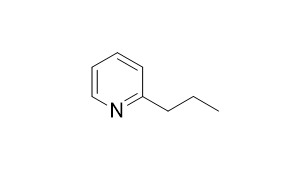2-Propylpyridine
2-Propylpyridine consistently imparts more translational energy in collisions than does 2-ethylpyridine and has larger energy transfer rates. Of the alkylated donors, 2-methylpyridine and 2-propylpyridine have larger probabilities for strong collisional energy transfer than does 2-ethylpyridine.
Inquire / Order:
manager@chemfaces.com
Technical Inquiries:
service@chemfaces.com
Tel:
+86-27-84237783
Fax:
+86-27-84254680
Address:
1 Building, No. 83, CheCheng Rd., Wuhan Economic and Technological Development Zone, Wuhan, Hubei 430056, PRC
Providing storage is as stated on the product vial and the vial is kept tightly sealed, the product can be stored for up to
24 months(2-8C).
Wherever possible, you should prepare and use solutions on the same day. However, if you need to make up stock solutions in advance, we recommend that you store the solution as aliquots in tightly sealed vials at -20C. Generally, these will be useable for up to two weeks. Before use, and prior to opening the vial we recommend that you allow your product to equilibrate to room temperature for at least 1 hour.
Need more advice on solubility, usage and handling? Please email to: service@chemfaces.com
The packaging of the product may have turned upside down during transportation, resulting in the natural compounds adhering to the neck or cap of the vial. take the vial out of its packaging and gently shake to let the compounds fall to the bottom of the vial. for liquid products, centrifuge at 200-500 RPM to gather the liquid at the bottom of the vial. try to avoid loss or contamination during handling.
Antioxidants (Basel).2021, 10(1):112.
Korean J. Crop Sci.2018, 63(2):131-139
PLoS One.2021, 16(9):e0257243.
Appl. Sci.2020, 10,1304
Manomaniam Sundaranar University2023, 3859769.
Nutr Res Pract.2020, 14(5):478-489.
BMC Microbiol.2019, 19(1):78
Cells.2023, 12(3):395.
Biomolecules.2020, 10(6):925.
J Appl Microbiol.2022, 132(2):949-963.
Related and Featured Products
Journal of Physical Chemistry A, 2007, 111(19):4073.
Alkylation effects on strong collisions of highly vibrationally excited alkylated pyridines with CO2.[Reference:
WebLink]
METHODS AND RESULTS:
The role of alkylation on the energy partitioning in strong collisions with CO2 was investigated for highly vibrationally excited 2-ethylpyridine (2EP) and 2-Propylpyridine (2PP) prepared with E(vib) approximately 38,570 and 38,870 cm(-1), respectively, using lambda = 266 nm light. Nascent energy gain in CO2 (00(0)0) rotation and translation was measured with high-resolution transient absorption spectroscopy at lambda approximately 4.3 microm and the results are compared to earlier relaxation studies of pyridine (E(vib) = 37,950 cm(-1)) and 2-methylpyridine (2MP, Evib = 38,330 cm(-1)). Overall, the alkylated donors impart less rotational and translational energy to CO2 than does pyridine. 2PP consistently imparts more translational energy in collisions than does 2EP and has larger energy transfer rates. Of the alkylated donors, 2MP and 2PP have larger probabilities for strong collisional energy transfer than does 2EP. Two competing processes are discussed: donors with longer alkyl chains have lower average energy per mode and fewer strong collisions but longer alkyl chains increase donor flexibility, leading to higher state densities that enhance energy loss via strong collisions. A comparison of state density effects based on Fermi's Golden Rule shows that 2PP has more strong collisions than predicted while 2EP has fewer. The role of torsional motion in the hot donors is considered.
CONCLUSIONS:
Comparison of effective impact parameters shows that the alkylated donors undergo strong collisions with CO2 via a less repulsive part of the intermolecular potential than does pyridine.



